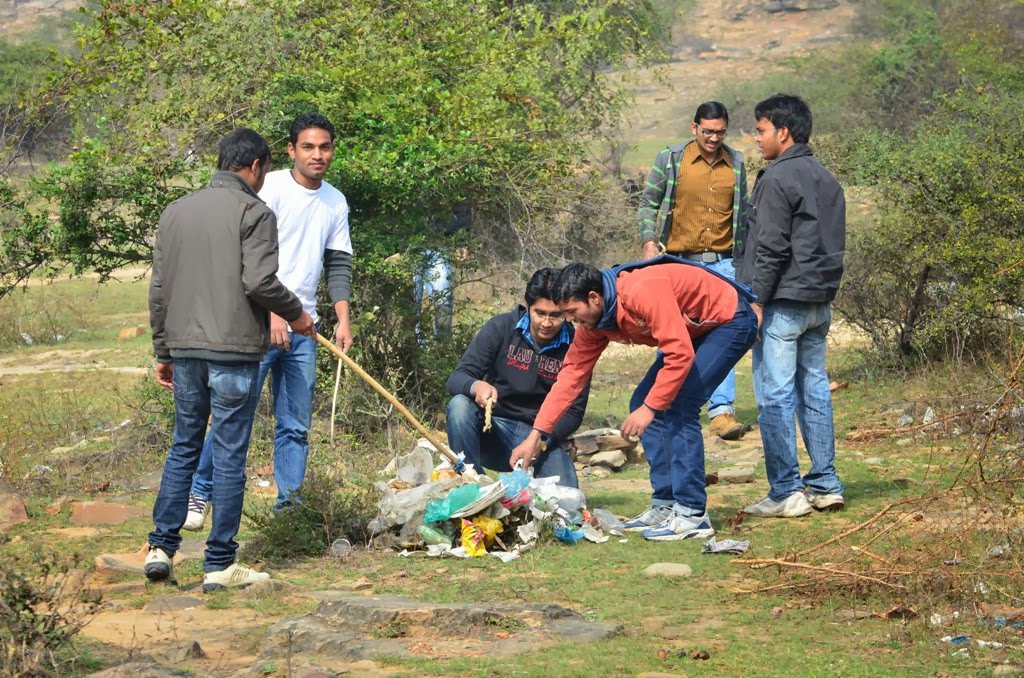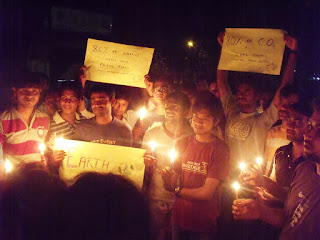Eco One has completed 2 successful months of existence in BHU. It is now standing strong with 180+ students as its foundation. In its latest addition Padmashree Prof. Lalji Singh, Vice Chancellor of our University has accepted to be our ‘Patron’. We are very much excited and honoured. It is indeed my happiest moment when I got the confirmation on telephone.
To read profile of Prof. Lalji Singh, click here
Here I am sharing you my personal experience while starting Eco One in brief. Hope you will enjoy reading it.
It was second week of January, one evening I was sitting with our OSD Prof. R.P. Singh. It was my first meeting with him and I knew nothing about him except what I heared from few teachers. I must say he is very straightforward person who likes to hear and speak straight. He asked, tell me your problem. I explained him what we want to do for the campus. To my surprise he was so unexpected. He showed encouragement for such initiatives. In the mean time Prof. Guru Prasad Singh joined the discussion. OSD Sir said.. ‘Let him deal with all of your activity. You can directly contact him and if he say yes, then its yes from me too.. He is another OSD for you’. It was my first interaction with both of them.
 |
| Navendu Nidhan, Co-Founder |
It was 24th January, 2012 when the foundation of Eco One was laid through this blog in room no. 66 of Shivalik Hostel. We didn’t know where it would head and what its fate is. We four friends were sitting in our hostel room making the registration form. While me and Navendu were busy designing and creating content for the blog, my room partner Jaydev was given the task to list all the courses in RGSC. Help came soon as Ram Bahadur step in in helping Jaydev. Then what? The Eco One blog was ready to publish. We knew we have very less time and our work is herculean keeping in mind the fact that we have hardly 3 months time left in campus. We were lucky to have friends like Ashutosh Mishra and Awanish Mishra for boosting our moral. But the confidence was high, our trust on each other was exceptional. There was nothing negative but positive positive and positive. I saw the young brigade really enthusiastic over formation of the eco club. We needed to spread the word as quickly as possible so as people of RGSC know us. We made internet and mouth to mouth publicity as our basic tool. Few notices were also put up on notice boards and walls after discussing with Prof. G.P. Singh. We made 2 students from each hostel as Ambassadors of each hostel.
26th January, 2012… Republic day celebration at Malaviya Park. Who can forget that day? After the sweets were distributed people threw the polythene wrappers everywhere. Slowly, the park and the admin block turned into mosaics of orange plastic bags. We started voluntarily collecting those polythene wrappers. It lasted 30 minutes during which every one present there watched us.. some laughed on us.. But we knew this is the initial spark of a large fire which is yet to come. Prof. G.P. Singh saw us and congratulated us for starting a unique initiative. Eco one made its first public appearance!
We did the advertisement by our work. People now know Eco One. Then we held the first meeting of Eco One management council on 31st Jan, 2012. Till then we had 87 registrations online! The basic organization of Eco One was decided that day by mutual consensus. I was elected Head, Navendu as Associate Head and Harshita as General Secretary. Ram Bahadur was elected treasurer while Ashutosh and Varsha were elected as Editor. Awanish was given the department of mobilization. Few other positions were discussed. The management council was later joined by Prakhar Parashar, Suryakant Upadhyay, Satya Prakash Tripathi, Hari Om Singh, Abhishek Pandey, Pankaj Gupta, Shishir Kumar and Prafulla Kumar.
 |
| Clean Windham Campaign on World Wetland Day |
2 days later was ‘World Wetland Day’. We decided not to celebrate it within a hall but do something through our action. What would have been the better place except Windham Fall. We talked with Prof. G.P. Singh and announced the first ever campaign to clean ‘Windham Fall’. We expected 50-60 students to turn out for the campaign. In our room Navendu and I were talking about how things will be successful. We were really very much worried. More than participation, discipline and security were also one of the reasons we were much worried. I talked with DFO Mr. Maneesh Mittal. Mr. Maneesh is a very different kind of prson is what I can say from all the interactions I had with him. He is also a kind of person who listens, understands and encourage every good initiatives. Within one day notice he confirmed provision of security at the place and himself assured to encourage the students by being present there. Finally the day came. We were waiting for students to register. Slowly, students started coming in front of Lecture Theater… and then.. keep coming…. Around 110 students participated. Eco One’s first mass campaign was successful! This lead to wide media attention.Prof. G.P. Singh was very happy with our work. He said, ‘Till now, people have come Windham Fall to enjoy and has always made it dirty… It was first time in history when people went there not for purpose of picnic but to clean it.’ The campaign led to many good things. Not only the fall was given a new life, but the problems were discussed directly with DFO on which he assured to take steps major being installation of dustbins, banners and security for accident prone areas.
Our OSD Prof. R.P. Singh was also very glad with the work and asked us to expand this idea to more people. He is a person who has been always supportive of good causes. In all the time I spent in south campus, I must say… Prof. R.P. Singh has been the most supportive OSD for students.
After that, with each passing day Eco One added more bricks to its foundation towards a larger and stronger roots. We were very close to Prof. G.P. Singh. We made him our Mentor which he accepted happily. HE has been not only just a mentor but a person whom we really see as father figure. He is the person who believes in building trust. In a very quick time we were very comfortable with him. His support and encouragement has been very crucial in success of Eco One. He never let us down. Whenever we need him he was there standing above us. His words works like magic each time we talk to him. I have very less words for Guru Prasad Sir for the kind of encouragement he has given not only to Eco One but all the emerging talents of RGSC. He was the perfect choice for Mentor of Eco One. As he always say, ‘Besides having so much corruption in a country of 121 crore population, still the GDP s 6% which is due to the meager percentage of people who are honest. The best way to defeat evil is joining hands with good and the evil will be less powerful.’
Then we organised ‘Eco Mania’ an open competition. Slogans, posters and photographs were invited. We got good quality participation in which some serious concerns were highlighted.
 |
| Management Council: Jaydev, Ram Bahadur, Ashutosh,Awanish |
This was followed by ‘Environ’ on 2nd March marking formal inauguration of Eco One. The event was marked by participation of almost all faculties and staff. On this day, the people who were left out till then were connected. Some prominent teachers who showed interest in supporting Eco One were Dr. Ashish Singh who is Campus Hostel Coordinator and Dr. Sunita Singh, Environment teacher of B.Ed. One of our important initiatives was joining hands with NSS of the campus. Dr. Ajay Singh announced officially that NSS and Eco One will support each other’s motive equally.
Next day, the first collaborative campaign of Eco One and NSS was organized. Dr. Somu Singh, Dr. Vinod Singh and Dr. Ajay Singh are also member of Eco One and at the same time coordinators for NSS. We planted 2 trees on behalf of us. OSD Sir inaugurated the relationship by planting the trees and assigning the duties to volunteer from Eco One and NSS. Students were very enthusiastic to discuss problems regarding waste in campus. OSD asked us to prepare a proposal for RGSC.
That day, we felt, there is a need of separate public participatory events to get the suggestions from the students. We planned a week dedicated to public participation. The week of 19th – 23rd March was selected by NSS for carrying out camps in nearby villages and Eco One planned a series of ‘Open Discussion on Waste’ in each hostel of RGSC. All the wardens and Hostel Coordinator agreed with that with active participation of themselves in each discussion.
Our first discussion was held at New Boys Hostel on 21st March and at Vindhyavasini Hostel on 22nd March. On 23rd March, OSD Prof. R.P. Singh and our Mentor Prof. G.P. Singh were present at Vindhyachal Hostel and actively moderated the discussion. The final discussion went good at the Shivalik hostel on 24th March. In all the discussions Dr. Ashish Singh, Dr. Somu Singh, Dr. Ajay Singh, Dr. Vinod Singh and Mr. Vijai Krishna were present personally and actively took part in the discussion.
 |
| Open Discussion Panel onWaste Management in RGSC @ Vindhyachal Hostel. | |
The Open Discussion series was overall a great experience for all of us. It was for first time when an open meeting of students and administration has happened to hear the problems and invite solutions from them. I see this as a great initiative where trust between administration and students will increase and we feel to be a part of Banaras Hindu University family.
24th March coincidentally also marked completion of 2 months for Eco One. And adding to our achievements we were honoured when I got the news on telephone that Vice Chancellor has accepted to be the ‘Patron’ of Eco One. Our journey couldn’t be better than this. I informed Prof. G.P. Singh first and then Navendu and others that Eco One is indeed lucky to have Prof. Lalji Singh as our Patron now.
We hope the same energy is carried to our next generation of Eco One. Eco One has reached this stage so quickly only because of positive people associated with it whether its Prof. R.P. Singh, Prof. G.P. Singh, Dr. Ashish Singh or Dr. Somu Singh to name a few. It’s a common encouragement and will… there is nothing negative in any of our approach. Eco One is a live example where we can see that with mutual trust and encouragement nothing is impossible. We share a common dream which we have been successful to convert into reality to great extent. Congratulations to all members of Eco One Management Council who has worked hard since its inception and gave their 110% contributions in all of the endeavours of Eco One. Our heartfelt thanks to all the faculty members who has encouraged the Eco One to grow and guided us in every possible way. Special congratulations to Navendu and Ashutosh!
We are very grateful to our Vice Chancellor and we are honoured to have him as our Patron. I can only say, our responsibilities are even more now!
~ Debadityo Sinha, M.Sc.(Tech.) Env. Sci., Sem VI
Head, Eco One Management Council










































.JPG)
.JPG)
.JPG)


+by+Eco+One+(11).JPG)

